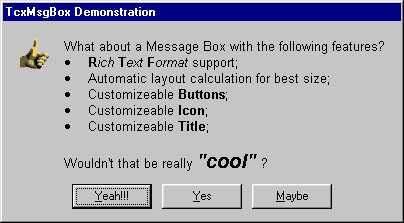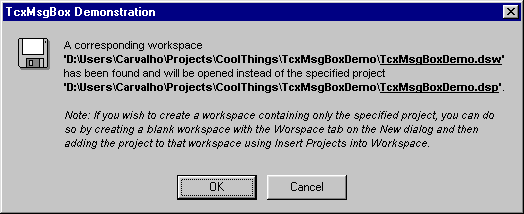| 12 users have rated this article. result: |
|
4.25 out of 5. |
Download demo project - 27 Kb
Download source - 7 Kb

Here I present a extended message box class for MFC applications (CTcxMsgBox).
It's an attempt to improve a couple of limitations of the regular API provided message box.
First, thanks to my friend Christian M. Garbin, who suggested I should prefix my classes
with my initials. Uh, I really haven't thought that before.
With a CTcxMsgBox, you can:
Customize the buttons. You can choose as many buttons as you need, and you can give them
whatever command ID and title you want. Therefore, you're not restrained to the old
Abort/Retry/Ignore,OK, OK/Cancel, Retry/Cancel, Yes/No,
Yes/No/Cancel schemas.
Select the default and the escape button.
Select any icon to decorate the message.
Display messages in Rich Text Format. Therefore, you can format your important messages
to really grab user's attention to what's important.
For example, the sample image is a snapshot of the message box created by the following code:
static const LPCTSTR _pMsg =
"{\\rtf1\\ansi\\deff0\\deftab720{\\fonttbl{\\f0\\fswiss MS Sans Serif;}{\\f1\\froman\\fcharset2 Symbol;}{\\f2\\froman Times New Roman;}{\\f3\\froman Times New Roman;}{\\f4\\fswiss\\fprq2 Arial;}}"
"{\\colortbl\\red0\\green0\\blue0;}"
"\\deflang1046\\pard\\plain\\f4\\fs20 What about a Message Box with the following features?"
"\\par \\pard\\li360\\fi-360{\\*\\pn\\pnlvlblt\\pnf1\\pnindent360{\\pntxtb\\'b7}}\\plain\\f4\\fs20\\b {\\pntext\\f1\\'b7\\tab}R\\plain\\f4\\fs20\\i ich \\plain\\f4\\fs20\\b T\\plain\\f4\\fs20\\i ext \\plain\\f4\\fs20\\b F\\plain\\f4\\fs20\\i ormat\\plain\\f4\\fs20 support;\\plain\\f2\\fs20 "
"\\par \\plain\\f4\\fs20 {\\pntext\\f1\\'b7\\tab}Automatic layout calculation for best size;\\plain\\f2\\fs20 "
"\\par \\plain\\f4\\fs20 {\\pntext\\f1\\'b7\\tab}Customizeable \\plain\\f4\\fs20\\b Buttons\\plain\\f4\\fs20 ;\\plain\\f2\\fs20 "
"\\par \\plain\\f4\\fs20 {\\pntext\\f1\\'b7\\tab}Customizeable \\plain\\f4\\fs20\\b Icon\\plain\\f4\\fs20 ;\\plain\\f2\\fs20 "
"\\par \\plain\\f4\\fs20 {\\pntext\\f1\\'b7\\tab}Customizeable \\plain\\f4\\fs20\\b Title\\plain\\f4\\fs20 ;\\plain\\f2\\fs20 "
"\\par \\pard\\plain\\f4\\fs20 "
"\\par Wouldn't that be really \\plain\\f4\\fs28\\b\\i \"cool\" \\plain\\f4\\fs20 ?\\plain\\f2\\fs20 "
"\\par }";
CTcxMsgBox msg( this );
msg.SetTitle( IDS_TITLE3 );
msg.SetRtf();
msg.SetMsg( _pMsg );
msg.SetIcon( IDI_THUMB );
msg.AddButton( IDC_YEAH, TRUE, FALSE );
msg.AddButton( IDC_YES, FALSE, FALSE );
msg.AddButton( IDC_MAYBE, FALSE, FALSE );
msg.DoModal();
To create _pMsg string, I simply edited a RTF file with Microsoft's Wordpad,
and opened it as plain text file in VC++. After that, I copied it to the C++ code,
not forgetting to replace all the backslashes for double-backslashes
(C/C++ syntax for constant strings).
Well, I could have used Microsoft's Word instead of Wordpad. But, as far as I could see,
Word puts a lot of default "framing" information in the file, even an empty file,
that just makes it bigger, but have no effect over the visual aspect of the RFT data.
Wordpad, for it's turn, gives us smaller data for the same result.
Another aspect of using RTF is the messages get bigger - mostly due to all the format
information. Therefore, sometimes even a small message with lots of formatting won't fit
in a single string slot of the resource's string table (each slot is limited to 512 UNICODE
characters).
If the message RTF data is this large, one solution for this problem is to split the message in
different parts and glue them all together in a CString object, before calling CTcxMsgBox.
Other solution is to use a CTcxMsgBox's mechanism that allows you saving messages as
custom resources. Custom resources are basically binary data that are saved in the resources section.
Just create a custom resource type, and one resource of this type for each message. Then, just "paste"
the message RTF data on the resource, and save it as binary. The Demo Application makes use of
this mechanism.
Another feature that makes life easier are all the FormatMsgXXX member functions.
They're similar to CString::Format, so you don't have to create a CString and format it
outside the message box. It does it for you.
Member functions
CTcxMsgBox( CWnd* pParentWnd = NULL )
Constructs a CTcxMsgBox object.
virtual ~CTcxMsgBox( void )
Destroys the object.
int DoModal( void )
Like CDialog::DoModal, this function displays the message box in modal mode
(the only one allowed). The function waits in the modal loop until the user presses a button
or dismisses the window by either closing it or pressing the esc key.
Then, the function returns the code of the command that was used to dismiss the message box.
void AddButton( UINT uIDC, BOOL bIsDefault, BOOL bIsEscape, LPCTSTR pszText )
void AddButton( UINT uIDC, BOOL bIsDefault, BOOL bIsEscape, UINT uIdText = (UINT)-1 )
Adds a custom button to the message box. Buttons must be added in the sequence they will appear
from left to right. Parameter uIDC is the button's command ID (e.g. IDOK). Parameter bIsDefault
sets this button as the default button, and overrides any previous added button that used this
style. Parameter bIsEscape sets this buttons as the escape button. Therefore, this button's
command ID will be returned if the user either closes the window or presses the esc key.
If no button is set as the escape button, the message box won't have the title's bar close button,
neither will it be dismissed by the esc key. Parameter pszText points to a string to title the
button. Parameter uIdText identifies a string, in the resource's string table, to title the button.
void SetTitle( LPCTSTR pszTitle )
void SetTitle( UINT uIdTitle )
Set the message box title. The default title, if this function is not used, is the application
name (AfxGetApp()->m_pszAppName). The parameters are obvious.
void SetRtf( BOOL bRtf = TRUE )
Sets the message box to work in RTF mode. The default mode after construction is "RTF OFF".
If the RTF is inactive, the object will work with messages as plain texts. The parameter is
obvious.
BOOL SetMsg( UINT uMsgId )
BOOL SetMsg( LPCTSTR pszMsg )
Set the message to be displayed. The parameters are obvious.
BOOL SetMsgEx( LPCTSTR pszMsgResId, LPCTSTR pszMsgResType )
Loads the message from a custom type resource. Parameter pszMsgResId is the resource ID.
If it's a UINT resource ID, use the MAKEINTRESOURCE to convert it to a LPCTSTR.
Parameter pszMsgResType is the resource type. The Demo Application has several samples of
using this mechanism.
BOOL FormatMsg( LPCTSTR pszFmt, ... )
BOOL FormatMsg( UINT uFmtStrId, ... )
Format the message to be displayed. See CString::Format for more information.
BOOL FormatMsgEx( LPCTSTR pszMsgResId, LPCTSTR pszMsgResType, ... )
Same as above. The only difference is that the formatting string is loaded from a
custom resource.
BOOL FormatMsgV( LPCTSTR pszFmt, va_list marker )
See C/C++ runtime library's vsprintf for details of this kind of construction.
void SetIcon( HICON hIcon )
void SetIcon( UINT uIcon )
Sets the icon to be displayed. If no icon is set there'll be no icon in the message box.
Well, that's pretty obvious. It's just to let you know that I don't put any undesired icon
in that place :).
void SetStandardIcon( LPCTSTR pszIconName )
Sets the icon to be displayed. The icon is one of the standard icons
(IDI_APPLICATION, IDI_HAND, IDI_QUESTION, IDI_EXCLAMATION, IDI_ASTERISK).
For more details, see CWinApp::LoadStandardIcon.
void SetMetric( int iMetric, int xy )
int GetMetric( int iMetric )
These functions are intended to advance use only. You can change some metrics of the message box,
like borders, gaps, etc. Parameter iMetric is the metric index. See the header file for
the metric indexes enumeration.
Final notes
Remember that message boxes are not a solution, but an anomaly of the UI universe.
A cool UI should use as few message boxes as possible. However, sometimes it's just that we don't
have the time or resources to design that cute ultimate smooth UI, and we finish using message boxes now and then.
One good thing about the CTcxMsgBox is that you can make your messages to really look
different, so improving the chances you'll grab user attention to what's really important
or catastrophic. Therefore, the risks a user will mistake an important message, thus giving it
a wrong order, by other he/she always gets in her/his way are lower.
For example, look at the following snapshots. The first is a regular VC++ message box. The second
is a "replacement" with CTcxMsgBox. Note how it really highlights the important information. If the
user never saw this message before, he/she would stop and pay attention to it. Besides, due to the
visual cues, experienced users can extract the important information quicker.


I hope you really enjoy this class. Even better, I hope you make good use of it - let me know by then.
And sorry for my not so wonderful English. This is not my first language, and besides I can write
good enough English, I generally demands some energy to do that. But that would mean I would never
have the time to write a good documentation, and to deploy the code. Therefore, I choose to be
a little bit loose with the writting, but to give you the good code anyway.
Files to include
The only files you need to include in you project are:
TcxMsgBox.h - the header file
TcxMsgBox.cpp - the code file
| Hint: For improved responsiveness, use Internet Explorer 4 (or above) with Javascript enabled, choose 'Use DHTML' from the View dropdown and hit 'Set Options'. |  New thread New thread | Messages 1 to 6 of 6 (Total: 6) | First Prev Next Last |
| |  | | Author |  |
|  | | Date |  |
|
 |  | | Uwe Keim | 9:19 20 Apr 01 |
 | | | Alex Lewandowski | 9:50 30 Mar 01 |
 | | | Miklos Kalman | 11:52 25 Oct 00 |
 | | | Andy Metcalfe | 1:21 11 Sep 00 |
 | | Thales P. Carvalho | 8:11 11 Sep 00 |
 | | | Harold Harkema | 11:00 26 Feb 00 |
 |
| | Last Visit: 12:00 Friday 1st January, 1999 | First Prev Next Last |
|
|




